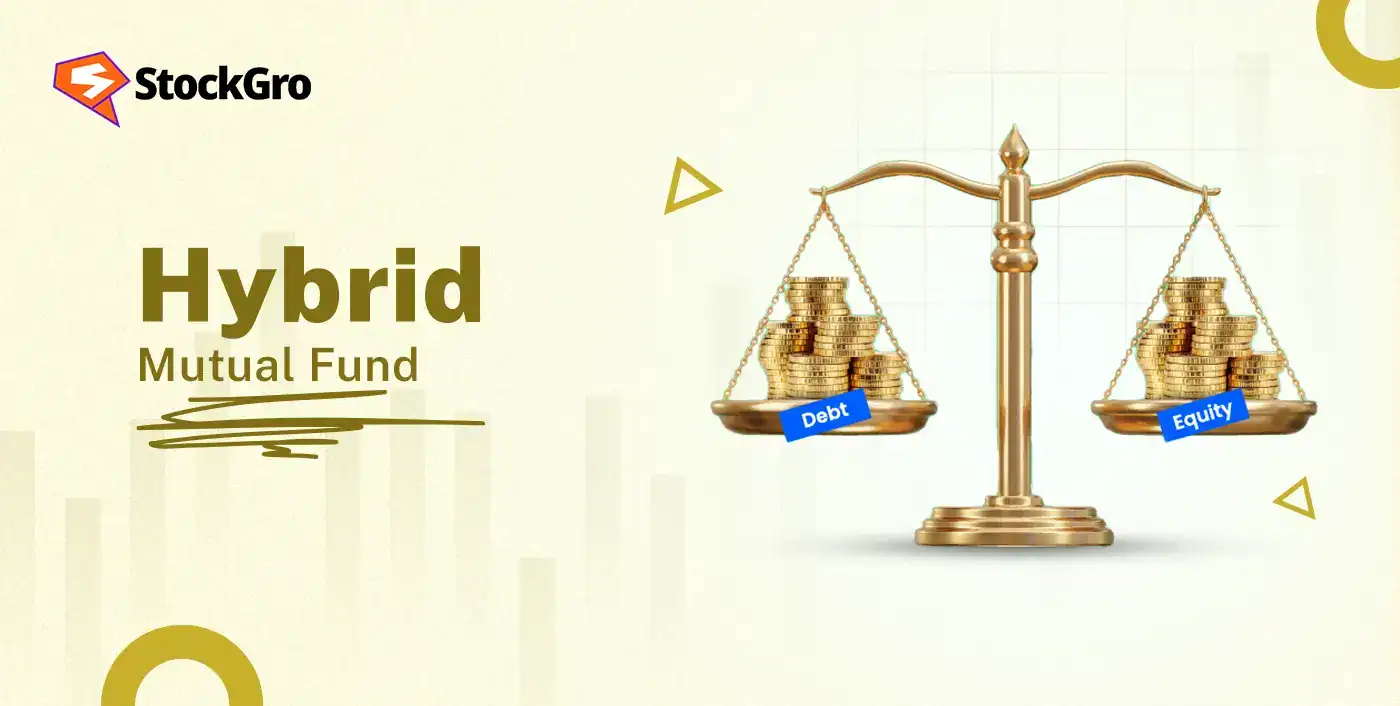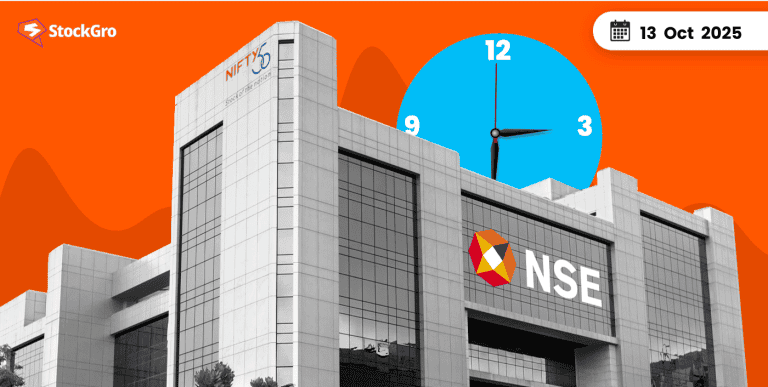
The Indian mutual fund industry has grown from ₹66.04 trillion in August 2024 to ₹76.71 trillion in August 2025, showing how more investors like you are entering the market. Within this rise, hybrid mutual funds have become one of the top three categories, accounting for about 6.7% (June 2025) of investor accounts.
Their appeal lies in how they blend equity and debt to balance growth with stability. If you want to see how they work, the types available, and what makes them relevant today, explore further through this blog.
What Are Hybrid Mutual Funds?
Hybrid schemes invest across varied assets such as equity, debt and sometimes in commodities or overseas markets. The main aim is to create a balanced allocation that helps balance risk & reward by combining growth-oriented and income-generating instruments.
Diversification of the investments is the appealing factor of hybrid funds. By spreading capital across uncorrelated assets, they try to balance market volatility while maintaining the potential for consistent gains. Therefore, each portfolio of these funds contains:
- Equity component: Adds long-term capital appreciation.
- Debt allocation: Provides predictable income and stability.
- Additional assets: Such as gold or global equities for further diversification.
So for investors, these mutual funds offer a pragmatic approach that potentially sits between the two extremes of cautious and aggressive investing.
Why Invest in Hybrid Mutual Funds?
These schemes appeal to investors looking for measured growth without extreme risk. Since they combine multiple exposure to maintain steadiness while allowing returns to build over time, the portfolio ensures resilience even when market sentiment shifts.
Each component contributes differently, helping smooth the investment journey and reduce overreliance on one segment. The mix of assets keeps returns consistent and risk contained.
- Balanced Risk & Reward: As we noted earlier, they merge equity’s expansion potential with debt’s steadiness, allowing returns to evolve without extreme volatility or sudden corrections.
- Multi-Layered Spread: Exposure across asset categories limits reliance on any single market, helping portfolios endure volatility with less disruption.
- Responsive Framework: Certain versions of hybrid funds recalibrate holdings automatically as market changes, sustaining alignment with prevailing trends..
- Investor Alignment: Choices exist for every choice, there’s a hybrid category to match your comfort level and time horizon, making it a versatile choice for varied investors..
- Sustained Momentum: Their structure encourages consistent participation across market cycles, building gradual progress rather than short-term gains.
7 Types of Hybrid Mutual Funds
Hybrid funds let you participate in both equity and debt markets without juggling multiple products. SEBI-Securities and Exchange Board of India has organised them into seven clear divisions, each designed for a different appetite for risk. You can choose where you belong on that spectrum:
| Type of hybrid mutual funds | Equity Allocation | Debt / Other Assets | Distinct Feature |
| Conservative hybrid fund | 10%–25% | 75%–90% | Prioritises security and income with limited equity exposure |
| Balanced hybrid fund | 40%–60% | 40%–60% | Maintains proportional mix for measured participation in markets |
| Aggressive hybrid fund | 65%–80% | 20%–35% | Designed for investors ready to accept higher movement for growth |
| Dynamic Asset Allocation / Balanced advantage fund | 0%–100% | 0%–100% | Adjusts allocation continuously in response to market dynamics |
| Multi asset allocation fund | Minimum 10% each | Minimum 10% each | Includes equity, debt, and other assets to widen portfolio scope |
| Arbitrage fund | Minimum 65% | Utilises pricing gaps | Employs arbitrage opportunities for steady, low-risk outcomes |
| Equity Savings Funds | Minimum 65% | Minimum 10% debt and derivatives | Combines equity, debt, and hedging for controlled participation |
Conservative Hybrid Fund
As the name suggests, roughly 75–90% are channelled into debt and 10–25% into equity. This format favours cautious participants seeking regular income and minimal instability in performance.
| Period (as of Oct 12- 2025) | Category-Average Return |
| 1 year | 4.98 |
| 3 years | 9.59 |
| 5 years | 9.47 |
Balanced Hybrid Fund
Both asset classes hold between 40–60% each. The arrangement maintains proportionate exposure, appealing to those preferring measured expansion over abrupt market-driven changes.
| Period (as of Oct 12- 2025) | Category-Average Return |
| 1 year | 3.38 |
| 3 years | 10.42 |
| 5 years | 12.71 |
Aggressive Hybrid Fund
Nearly 65–80% resides in equity and 20–35% in debt. It attracts investors ready for periodic fluctuations while pursuing stronger long-term advancement.
| Period (as of Oct 12- 2025) | Category-Average Return |
| 1 year | 1.68 |
| 3 years | 15.6 |
| 5 years | 17.76 |
Dynamic Asset Allocation / Balanced Advantage
The mix can vary anywhere from 0–100% in either equity or debt. Adjustments occur continuously, reflecting prevailing conditions and maintaining disciplined composure through economic shifts.
| Period (as of Oct 12- 2025) | Category-Average Return |
| 1 year | 2.07 |
| 3 years | 12.89 |
| 5 years | 12.9 |
Multi-Asset Allocation Fund
Investment extends to at least 3 classes, holding a minimum 10% in each. It often includes equity, debt, and gold, expanding reach and diluting concentration risk.
Arbitrage Hybrid Fund
A minimum 65% remains within equities and related holdings. It benefits from pricing discrepancies across markets, delivering steadier outcomes with restrained unpredictability.
| Period (as of Oct 12- 2025) | Category-Average Return |
| 1 year | 6.07 |
| 3 years | 6.81 |
| 5 years | 5.59 |
Equity Savings Fund
This type keeps at least 65% in equities, 10% in debt and the remainder in others. This composition helps you stay invested while keeping movement contained. Unlike other hybrid variants, these funds integrate arbitrage positions, which takes advantage of pricing gaps across markets to offset volatility. It keeps your portfolio steady even when conditions shift abruptly.
| Period | Category-Average Return |
| 1 year | 4.85 |
| 3 years | 10.34 |
| 5 years | 10.73 |
How Hybrid Funds Work
Hybrid funds combine equity and debt within one portfolio. Fund managers decide this proportion of each asset based on the particular fund’s type, purpose and the current environment. They may alter equities when markets look attractive or go for debt during uncertain stretches.
Some categories adjust their mix automatically through predefined models. This flexibility allows investors to remain aligned with market movements without constant tracking.
Hybrid funds let you participate in different market cycles without constant oversight. They maintain discipline, adjust positioning and keep your portfolio steady while pursuing long-term progress.
Tax Implications of Hybrid Funds
Taxation for hybrid mutual funds depends on how much of the investment is allocated to equities. The higher the equity component, the more advantageous the tax treatment. Funds with 65% or more equity are treated as equity-oriented, while those below that threshold fall under specified mutual fund taxation.
Equity-oriented hybrids enjoy 12.5% long-term capital gains tax on holdings above 12 months, with gains up to ₹1.25 lakh exempt each financial year. If redeemed earlier, short-term gains attract 20% tax.
Debt-oriented hybrids follow regular income tax rules. For units purchased after 1 April 2023, profits are added to your taxable income and taxed as per your slab.
| Investment Period | Holding Period | Tax Type | Applicable Rate |
| Equity Allocation ≥ 65% | Less than 12 months | Short-Term | 20% |
| More than 12 months | Long-Term | 12.5% after ₹1.25 L exemption | |
| Equity Allocation < 65% (Post-April 1 2023) | Any duration | Short-Term/ Long-Term | As per slab |
How to Choose the Right Hybrid Fund
Choosing one starts with clarity of intent. You should identify whether your priority is stability, income generation, or capital progression. Every structure aligns uniquely with time, risk appetite, and financial outlook.
- Define your investment horizon: If your goals are closer, consider conservative or multi-asset formats that hold more debt and provide steadier returns. With a longer horizon, you can lean toward dynamic or growth-focused options that draw strength from equity exposure.
- Assess your risk appetite: If you prefer consistency, select portfolios that keep equity exposure measured. But if you can handle fluctuations, equity-heavy schemes can help your wealth compound faster.
- Check portfolio composition: Look at how allocation shifts between equity and debt. Dynamic frameworks adjust naturally, keeping you aligned with evolving market conditions.
- Evaluate debt quality: Ensure the debt side focuses on quality instruments. Avoid portfolios that chase extra yield at the cost of stability.
- Consider expenses: Expense ratios may seem small but they add up over time. Choosing a fund with lower ongoing costs helps preserve more of your gains and strengthens long-term performance.
Recent Trends in Hybrid Fund Investments
- Holdings climbed to ₹10.33 lakh crore in September 2025, marking a 2.5% monthly increase.
- Multi-asset allocation schemes registered the strongest advance, expanding 6.3 per cent to ₹1.40 lakh crore and drawing ₹4,982 crore in inflows.
- Balanced and aggressive formats followed closely as investors sought options that could adapt through shifting conditions while maintaining disciplined risk control.
- Unlike other global markets that witnessed outflows, India maintained steady inflows into hybrid portfolios. Supportive macroeconomic cues, easing commodity costs and persistent investor confidence strengthened the momentum across categories.
FAQ‘s
They are grouped based on how the investment pool is split between equity, debt, and other assets. Each serves a different level of risk and return expectation. Categories include conservative, balanced, aggressive, dynamic, multi-asset, arbitrage and equity savings.
One focuses more on debt, offering steadier movement with limited market exposure. The other leans toward equity, allowing greater participation but with higher fluctuation. The distinction lies in how each balances safety and growth.
Tax treatment depends on how much is held in equity. Schemes with higher equity exposure follow equity rules, while those with more debt are taxed as per income slabs. Holding period also influences the rate applied.
It adjusts its mix of equity and debt based on market conditions. The allocation changes automatically to balance growth and stability. This flexibility helps manage movement across different phases of the market.
They suit those seeking measured exposure to markets with limited swings. The mix of equity, debt and arbitrage offers steadier outcomes. It works well for investors preferring balance over aggression.
More people are turning to these schemes because they offer balance in uncertain conditions. The structure blends equity and debt, helping investors stay invested through market swings. Simpler management and moderate risk make them practical for a wide range of goals.

